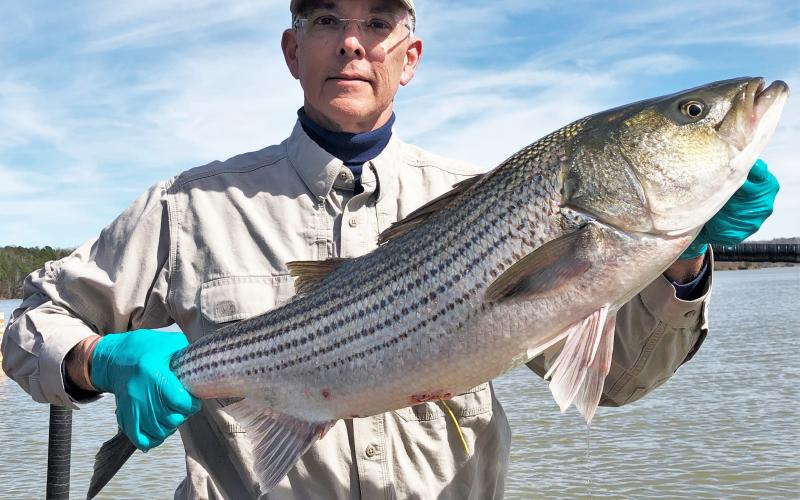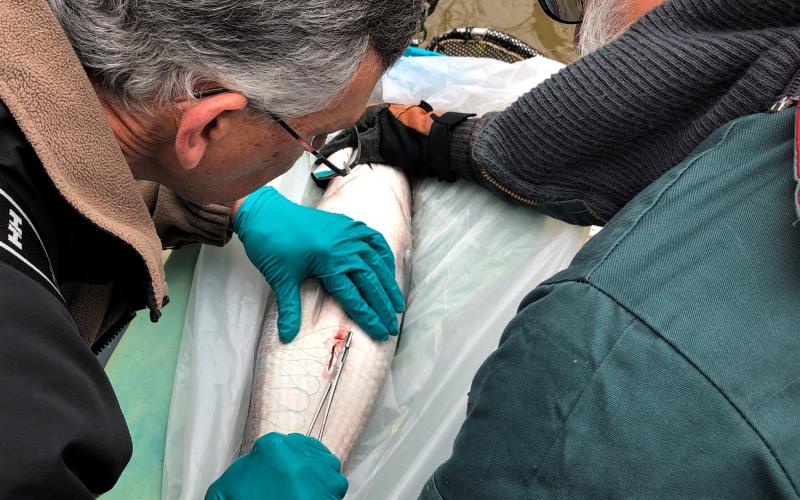A transmitter placed in a highly sought sport fish by the state Department of Natural Resources on Lake Hartwell apears to be a “kiss of death” for striped bass.
Since the DNR began its striped bass telemetry project, one transmitter has been caught by anglers and recycled four times already.
Fisheries biologist Anthony Rabern, who spearheads the project started more than a year ago, told The Sun that transmitter was dubbed “unlucky” because whichever fish it was placed in seemed to get harvested.
“Whatever poor fish got that seemed to get caught pretty quickly,” Rabern said. “So that transmitter I deemed it unlucky ... It’s still out there now so finally some fish broke the string and is able to survive with that unlucky transmitter.”
About 45 fish are currently tagged in Lake Hartwell, and the DNR can keep track of their movement via receivers located on the lake.
The project has provided wildlife management officials with a large amount of data, Rabern said, and more insight into the seasonal habits of Lake Hartwell’s striped bass population.
“The whole goal of the project was to track these individual stripers and hopefully predict how, as a population, they move around the reservoir throughout the course of the year,” Rabern said. “I think we have a much better picture of that than we did before the study.”
The study is also providing the DNR with data about striped bass survival rates and can even show them how many tagged fish died due to natural causes or angler mortality. This data is used to determine regulations and set creel limits.
Preliminary data shows angler harvest is not at an extremely high level, Rabern said, meaning size limits and creel limits probably won’t be adjusted.
In the winter, Rabern said about half of the tagged fish were found in the lower part of the Seneca River near Broyle’s Landing.
Once springtime rolls around, striped bass “are really scattered all over the place.” Rabern said they move into the major tributaries that feed the lake and are almost equally scattered all over the lake during the spring months.
The summer heat drives the stripers out of the cove areas, Rabern said, and they migrate more toward the dam and into the deeper waters to escape the surface water heat. Data collected shows 62 percent of the tagged fish are somewhere near the dam in the lower Savannah River section.
“They’re in the vicinity, within eye-shot, of the dam,” Rabern said. “But we are still seeing fish at every part of the lake, but very low numbers.”
Rabern said the DNR wants to see how the stripers respond to the thermocline, a thin, deep layer of oxygenated water stripers need to survive, as it begins to shrink and disappear through the summer. Last year was unique, Rabern said, because the layer completely disappeared and was “virtually gone by the first of September.”
“The behavior of striped bass in Lake Hartwell last year was very different than any other year,” Rabern said.
Observing an anomaly year showed the DNR that when that layer disappeared, the striped bass returned to their “home stream.”
“It seems like these fish have picked out a cove arm of the lake and they keep going back to that,” Rabern said. “I call it their home stream. They keep going back home when things are tough. That’s where they spawn when things are really tough in the summer if they can’t hack it at the dam.”
High flows out of the dam caused by heavy rain, with the addition of a hot summer, caused the thermocline layer to nearly disappear last year, Rabern said.
But he is hopeful this year will bring more typical summer weather to provide the DNR with data about a regular year.
As the weather cools the water down into the fall months, the striped bass start to redistribute and disperse throughout the lake, Rabern said.
If you catch a tagged striped bass, you might not even know it, Rabern said. But if you do notice a small incision on the striper’s belly, Rabern said to do what you would normally do with the fish. If an angler cleans the fish and finds a transmitter, the DNR asks for anglers to return it.
There are some striped bass with external tags, Rabern said, and one of those fish was caught, released and reported to the DNR four different times.
“Crazy stuff is happening and it’s interesting to watch that unfold,” Rabern said.
The project will hopefully be wrapping up by the end of this year, Rabern said, and he hopes data will give the DNR a picture of more typical migration patterns so they can learn more about the lake’s ability to support bigger fish.
“And that’s what everybody wants. They want more 20-pound stripers,” Rabern said. “And that’d be our goal. We share that same vision as anglers. We want to see more trophy stripers in the lake.”


